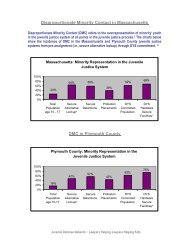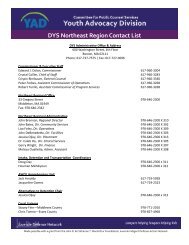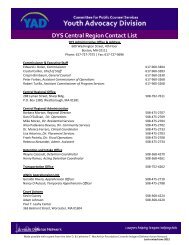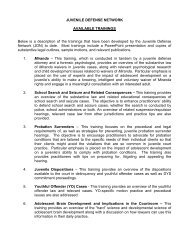States rethink 'adult time for adult crime' - the Youth Advocacy Division
States rethink 'adult time for adult crime' - the Youth Advocacy Division
States rethink 'adult time for adult crime' - the Youth Advocacy Division
Create successful ePaper yourself
Turn your PDF publications into a flip-book with our unique Google optimized e-Paper software.
Two companies, No Lie MRI and Cephos, are now competing to refine f.M.R.I.<br />
lie-detection technology so that it can be admitted in court and commercially<br />
marketed. I talked to Steven Laken, <strong>the</strong> president of Cephos, which plans to begin<br />
selling its products this year. “We have two to three people who call every single<br />
week,” he told me. “They’re in legal proceedings throughout <strong>the</strong> world, and<br />
<strong>the</strong>y’re looking to bolster <strong>the</strong>ir credibility.” Laken said <strong>the</strong> technology could have<br />
“tremendous applications” in civil and criminal cases. On <strong>the</strong> government side,<br />
he said, <strong>the</strong> technology could replace highly inaccurate polygraphs in screening<br />
<strong>for</strong> security clearances, as well as in trying to identify suspected terrorists’ native<br />
languages and close associates. “In lab studies, we’ve been in <strong>the</strong> 80- to 90-<br />
percent-accuracy range,” Laken says. This is similar to <strong>the</strong> accuracy rate <strong>for</strong><br />
polygraphs, which are not considered sufficiently reliable to be allowed in most<br />
legal cases. Laken says he hopes to reach <strong>the</strong> 90-percent- to 95-percent-accuracy<br />
range — which should be high enough to satisfy <strong>the</strong> Supreme Court’s standards<br />
<strong>for</strong> <strong>the</strong> admission of scientific evidence. Judy Illes, director of Neuroethics at <strong>the</strong><br />
Stan<strong>for</strong>d Center <strong>for</strong> Biomedical Ethics, says, “I would predict that within five<br />
years, we will have technology that is sufficiently reliable at getting at <strong>the</strong> binary<br />
question of whe<strong>the</strong>r someone is lying that it may be utilized in certain legal<br />
settings.”<br />
If and when lie-detection f.M.R.I.’s are admitted in court, <strong>the</strong>y will raise vexing<br />
questions of self-incrimination and privacy. Hank Greely, a law professor and<br />
head of <strong>the</strong> Stan<strong>for</strong>d Center <strong>for</strong> Law and <strong>the</strong> Biosciences, notes that prosecution<br />
and defense witnesses might have <strong>the</strong>ir credibility questioned if <strong>the</strong>y refused to<br />
take a lie-detection f.M.R.I., as might parties and witnesses in civil cases. Unless<br />
courts found <strong>the</strong> tests to be shocking invasions of privacy, like stomach pumps,<br />
witnesses could even be compelled to have <strong>the</strong>ir brains scanned. And equally<br />
vexing legal questions might arise as neuroimaging technologies move beyond<br />
telling whe<strong>the</strong>r or not someone is lying and begin to identify <strong>the</strong> actual content of<br />
memories. Michael Gazzaniga, a professor of psychology at <strong>the</strong> University of<br />
Cali<strong>for</strong>nia, Santa Barbara, and author of “The Ethical Brain,” notes that within 10<br />
years, neuroscientists may be able to show that <strong>the</strong>re are neurological differences<br />
when people testify about <strong>the</strong>ir own previous acts and when <strong>the</strong>y testify to<br />
something <strong>the</strong>y saw. “If you kill someone, you have a procedural memory of that,<br />
whereas if I’m standing and watch you kill somebody, that’s an episodic memory<br />
that uses a different part of <strong>the</strong> brain,” he told me. Even if witnesses don’t have
















